Ata-ul-Haye Nasir, Ahmadiyya Archive & Research Centre
Hazrat Mirza Ghulam Ahmadas of Qadian, the Promised Messiah and Mahdi, states:
“God Almighty desires to draw all those who live in various habitations of the world, be it Europe or Asia, and who have virtuous nature, to the Unity of God and unite His servants under one Faith.” (The Will [Al-Wasiyyat], pp. 8-9)
The writings, claims, and prophecies of the Promised Messiahas had reached far and wide during his life through various periodicals around the world, and this continued after his time as well.
We found several periodicals in French that served as a means to spread the message of the Promised Messiahas.
It is worth acknowledging that the periodicals might incorporate particular perspectives pertaining to the Promised Messiah’sas claims and Ahmadiyyat, which they based on their own comprehension or convictions. Consequently, such interpretations should not be misconstrued as a comprehensive or accurate representation of the viewpoints or beliefs espoused by the Ahmadiyya Muslim Community.
Some examples from those newspapers, translated from French, are given below.
In 1899, Journal des Débats Politiques et Littéraires wrote:
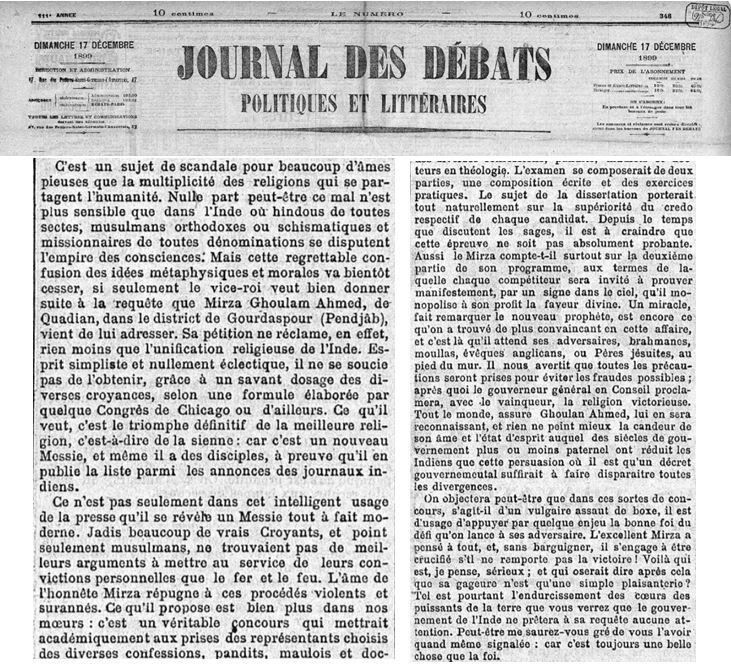
“The multiplicity of religions that share humanity is a subject of concern for many pious souls. Perhaps nowhere is this issue more perceptible than in India, where Hindus of all sects, orthodox or schismatic Muslims, and missionaries of all denominations dispute the empire of consciences. But this regrettable confusion of metaphysical ideas and morals will soon cease if only the Viceroy [of India] will follow up on the request that Mirza Ghulam Ahmed[as] of Qadian, in the district of Gurdaspur (Punjab), has just addressed to him. His appeal calls for nothing less than the religious unification of India. Simplistic in spirit and in no way eclectic, he does not care to obtain it, thanks to a learned proportioning of the various beliefs, according to a formula worked out by some Congress in Chicago [in 1893] or elsewhere. What he wants is the definitive triumph of the best religion, that is to say, his own: for he is a new Messiah, and he even has disciples; as proof, he publishes the list among the announcements of the Indian newspapers.
“It is not only in this intelligent use of the press that he reveals himself to be a completely modern Messiah. In the past, many true believers, not just Muslims, found no better arguments to serve their personal convictions than iron and fire. The soul of the honest Mirza[as] is repugnant to these violent and antiquated methods. What he proposes is much more in line with our manners; it is a real contest that would academically bring together selected representatives of the various denominations, pundits, maulvis and doctors of theology. The contest would consist of two parts, a written essay and practical exercises. The topic of the dissertation would naturally relate to the superiority of each candidate’s respective credo. Since the time that the sages have been discussing, it has been feared that this test will not be absolutely conclusive. Also, the Mirza[as] counts above all on the second part of its programme, under the terms of which each competitor will be invited to prove manifestly, through a heavenly sign, that he has monopolised the divine favour […]. A miracle, points out the new prophet, is still what has been found most convincing in this affair, and it is there that he awaits his adversaries, Brahmans, moullas, Anglican bishops, or Jesuit Fathers, at the foot of the wall. He cautions us that all precautions will be taken to avoid possible fraud, after which the Governor General in Council will proclaim, with the conqueror, the victorious religion. Ghulam Ahmed[as] assures that everyone will be grateful to him. […]
“The excellent Mirza[as] has thought of everything, and without hesitation, he undertakes to be crucified if he does not win the victory! This is, I think, serious […]. Such, however, is the hardening of the hearts of the powerful of the earth that you will find that the government of India will pay no heed to his request. Perhaps you will be grateful to me for pointing it out to you all; for faith is always a beautiful thing.” (Journal des Débats Politiques et Littéraires, 17 December 1899, p. 2)
In relation to the Promised Messiah’sas challenge to Dr Alexander Dowie, Le Petit Journal wrote in 1903 under the heading “A Prayer Duel” that Hazrat “Mirza Ghulam Ahmad[as] from Punjab,” British India, “claims to be the Messiah promised by the prophets,” and has “sent a challenge to the American competitor. He comes, by a special message, to urge Dr Dowie to contest him in the field [of a prayer duel].” (Le Petit Journal, 18 July 1903, p. 6)
It is important to note that this particular article also includes certain words, such as, “took umbrage” and “fearing for his prestige”, which seem to suggest that, God forbid, the Promised Messiahas was prompted to challenge Dr Dowie as a result of his personal rivalry or with an intention to safeguard his own repute. However, this perspective is completely incorrect. John Alexander Dowie claimed to be the third coming of Elijah and prophesied the return of Jesus Christas within 25 years. He carried out vile attacks on the beautiful teachings of Islam and the blessed life of the Holy Prophet Muhammadsa, moreover, he expressed his desire to efface Islam from the face of the earth. (“The Prayer Duel”, www.reviewofreligions.org)
Owing to these reasons and his jealousy for the honour of Allah and the Holy Prophet Muhammadsa, Hazrat Ahmadas cautioned Dr Dowie to stop attacking Islam and its Holy Foundersa. Moreover, he invited Dr Dowie to a prayer duel, with the aim of proving the truthfulness and majesty of Islam.
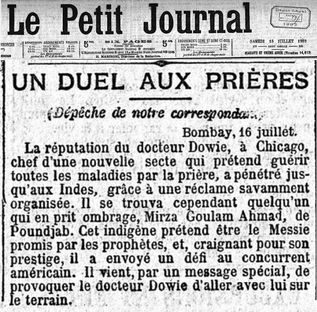
A prominent French writer, M Pierre Mille (1864-1941) wrote:
“A new Messiah has just appeared; let it be said! […]
“He is the Messiah and Mahdi at the same time, in the European sense that we give to this word because he does not limit his propaganda, as the others did, to the Muslim countries. […] He has missionaries, whom he sends everywhere, and one of them has just preached in Paris, then in Marseille.
“Ghulam Ahmad[as]” has “made a thousand predictions, all of which, it seems, have come true. I readily believe that the predictions always come true. In this regard, it is enough to draw a little on the prophecy, on the one hand, and on the facts, on the other.” (La Dépêche Coloniale et Maritime, 22 November 1923, p. 2)
This article was also published in Excelsior on 23 November 1923.
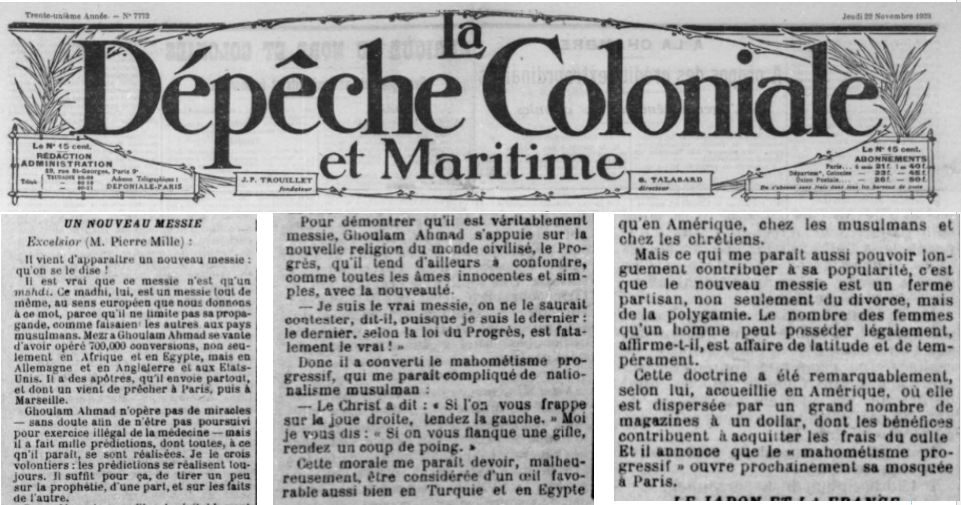
An article authored by Guy Mazeline (1900-1996), states:
“A Prophet’s envoy is passing through Marseille.
“Dr Mufti Muhammad Sadiq, after a long trip around the world, is now in our city. Sent by the [Second Successor of the] Prophet Mirza Ghulam Ahmad[as], he went to bring the good word to Africa, Egypt, Germany, and England. The number of his conversions exceeds 700,000. The great Prophet Mirza[as] lives at Qadian, amongst the Punjabi and the tigers, at the foot of the Himalayan mountains and for twenty years Muhammad Sadiq has lived in his company. […]
“Muhammad Sadiq has a vast mission. He propagates the essential virtues of the Mohammedan [sic, Islamic] religion and the precepts of Ghulam Ahmad[as], who said:
“‘I have been informed, by clear and full revelation, that I am the Promised Messiah for the times which are beginning, and that I am also the Man who is to appear in due time, sent by God to revive the Islamic faith, which is weakening.’
“And like any strong religion, it has martyrs, we venerate, over there in Qadian, the memory of Maulvi Syed Abdul Latif[ra], stoned in Afghanistan by the clerics of Kabul. By virtue of this great heroism and his ideal, the [preaching of the teachings of] Prophet Ghulam [Ahmadas] brings about new conversions every day. And it is to him that all the honour and merit belongs, for he is the inspired interpreter of the revealed law, the modern Christ […]
“He is also the one who built the Ark to save the people from the deluge of scepticism, obscurantism, immorality, misery, and corruption. He is the one who has published 80 books and made a thousand prophecies. His books have been read by countless readers and his prophecies have been fulfilled.” (Le Petit Marseillais, 7 November 1923, pp. 1-2)
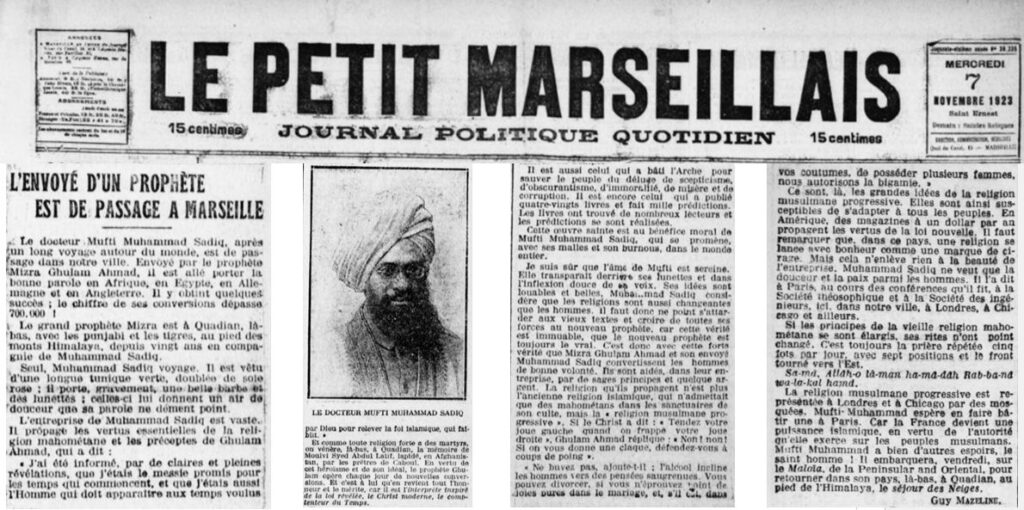
L’Événement wrote:
“Here is the origin of this Movement. The Founder of the sect, Mirza Ghulam Ahmed[as] (1836-1908), from a very old noble family, studied Christianity in depth. […] Claiming to be the [second coming] of the god Krishna, Jesus, and the Hindu Messiah Mahdi, he preached all over India, predicting the future and manifesting miracles.
“In 1896, several […] Ahmadis held a council in Lahore. They decreed that Ahmed’s[as] followers, while recognising the Quran, must believe in Ahmed[as] as the Messiah. […]
“Despite its opposition, Ahmadiyyat has developed more and more; its missionaries travelled through West Africa, America and Europe, as Ahmed[as] claimed that most Europeans would convert to his religion [Islam Ahmadiyyat]. The Ahmadis are even in the process of building a superb mosque in Berlin (Charlottenburg).” (L’Événement, 3 January 1924, p. 3)
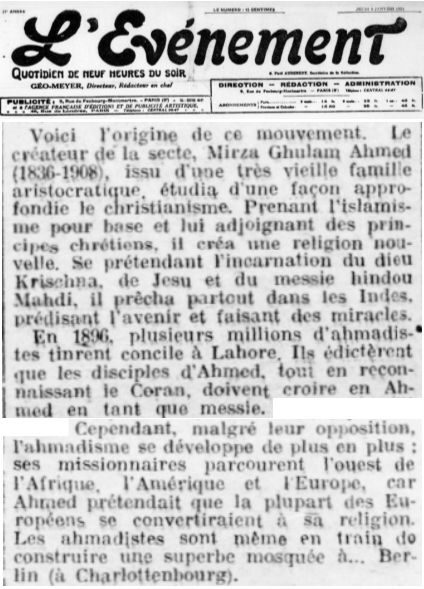
In 1926, Henri Lammens, a Belgian Jesuit in Lebanon, wrote in his book “L‘Islam: Croyances et Institutions”:
“[Translation from French by Sir E Denison Ross]
“AHMADIYYA: A more recent reformist movement in Islam, dating from 1880 [the year when the first two parts of Barahin-e-Ahmadiyya were published], has resulted in the creation of a new sect, that of the ‘Ahmadiyya’. The founder from whom it takes its name, Mirza Gholam Ahmad[as] (d. 1908), a native of Qadian in the Punjab (India), claimed to have discovered the veritable tomb of [Jesusas] Christ, who,” he claimed, “had found refuge in India and died there. This find served as the starting point of Ahmadiyya. Its three chief novelties are its Christology, its theory of the Mahdi and that of the jehad. It is this last which gives it an appearance of Islamic reform.” (Islam: Beliefs and Institutions [L‘Islam: Croyances et Institutions], Translated by Sir E Denison Ross, 1929, Methuen & Co. Ltd., London, p. 188)
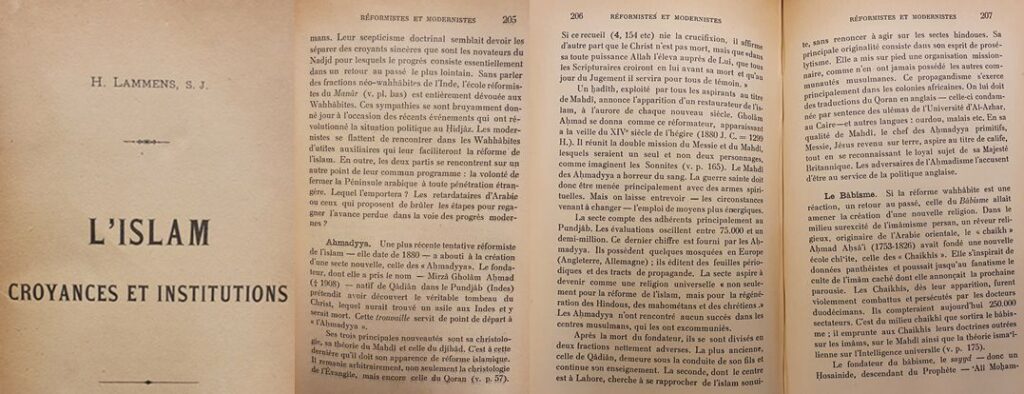
He further states:
“A hadith,” utilised “by all aspirants to the title of Mahdi, announces the appearance of a restorer of Islam, at the dawn of each new century. Gholam Ahmad[as] gave himself out as this reformer, appearing on the eve of the fourteenth century of the Hijra (1880 A.D. = 1299 A.H.). He combined the double mission of the Messiah and the Mahdi, whom he declared to be one and not two persons, as the Sunnis suppose (v. p. 149). The Mahdi of the Ahmadiyya has a horror of bloodshed. The Holy War must therefore be waged chiefly with spiritual weapons.” (Ibid.)
He continues:
“The sect numbers adherents chiefly in the Punjab, variously estimated at seventy-five thousand to half a million. The latter figure is furnished by the Ahmadiyya. They possess a few mosques in Europe (England, Germany). They edit periodicals and propagandist tracts. The sect aspires to become, as it were, a universal religion ‘not only for the reform of Islam, but for the regeneration of the Hindus, Muhammadans [sic., Muslims] and the Christians.’ […]
“After the death of the Founder, they divided into two distinctly opposite factions. The older, that of the Qadian, remains under the conduct of his son [Hazrat Mirza Bashir-ud-Din Mahmud Ahmad, Khalifatul Masih IIra] and continues his teaching. The second, whose centre is at Lahore, seeks to draw near to Sunni Islam without renouncing its activity amongst the Hindu sects.” (Ibid., p. 189)
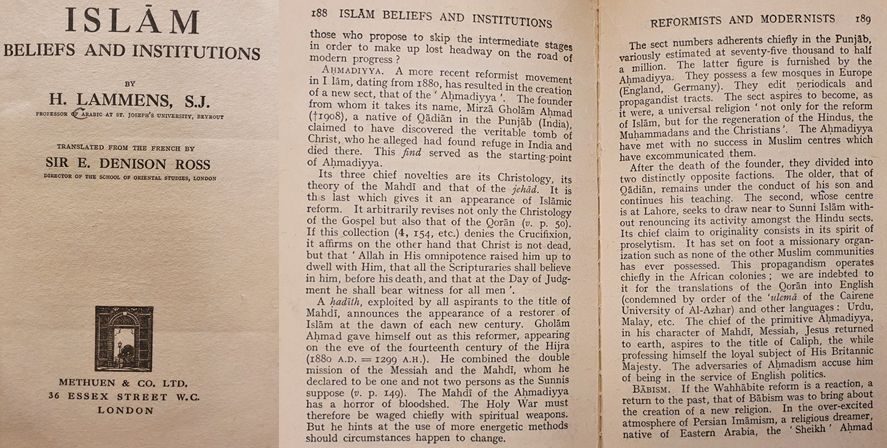
In 1943, a revised edition of this book was published from Beirut, with some further details. It also referenced a letter, dated 18 April 1927, from Sheikh Yousuf Ali Sahib, the then Private Secretary to Hazrat Khalifatul Masih IIra. The following quotation from that letter was included in the revised edition:
“God raised him [Hazrat Ahmadas] up for the regeneration of mankind in our time, in accordance with the predictions of all the great prophets of the world: Muhammad[sa], Jesus[as] Christ, Daniel[as], Isaiah[as] and other prophets of the Bible, as well as the great prophets of the East, such as Krishna[as], Zoroaster[as], Buddha[as] and others.” (L‘Islam: Croyances et Institutions, Beirut, 1943, p. 244)
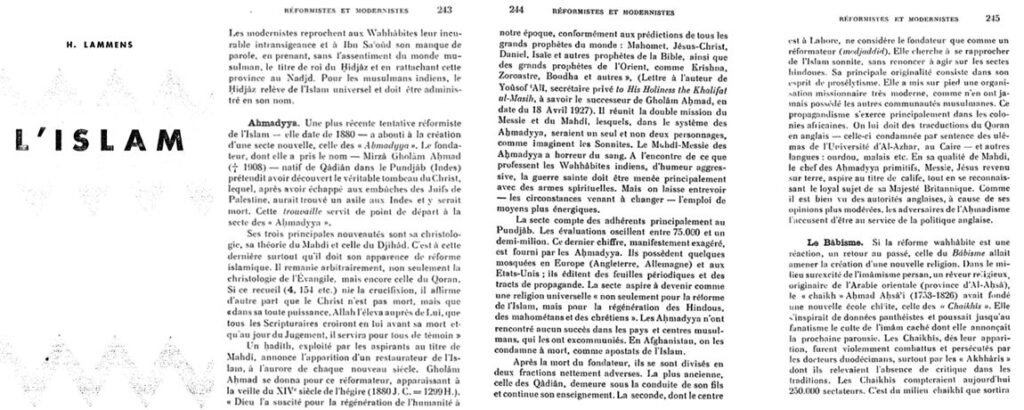
Journal des Missions Évangéliques wrote:
“The Ahmadiyya Movement
“We extract the following passages from the review ‘En Terre d’Islam’:
“‘Islam has not stopped its universal aspirations: the current activity of the Muslim missionaries is proof of this. Its efforts are, indeed, noticeable in England: a mosque in Woking, the laying of the first stone of the mosque in London in October 1924, an attempt by the Imam to erect a mosque in Brussels in 1925, and 200 English Mohammedans….
“‘The Ahmadiyya sect is of particular interest, as it claims to win the Crescent Europe as well as the rest of the world…. Its present leader, Hazrat Mirza Bashir-ud-din Mahmud Ahmad[ra], writes: ‘The Ahmadiyya community is a model of purity and devotion. Our opponents themselves admit that the conversion to Ahmadiyya changes the affinity of the heart and gives strength to the martyrs.’
“‘The Holy War has now turned into a contest of doctrines, thanks to bold aplomb, eloquence unconcerned with erudition, and enthusiastic publicity. (Press: five newspapers in India, two in Ceylon, one in Mauritius, a quarterly review in Chicago, and monthly in London and Woking.) The Ahmadiyya sect is growing day by day. […] It presents itself as a ‘middle term’ between orthodox Mohammedanism [sic., Islam] and the rationalism that has infiltrated the Islamic bloc through the school of Aligarh.
“‘This Ahmadiyya movement is therefore essentially a response of Islam against the invasion of European civilization and the few successes of the Christian missionaries. It is an attempt to channel the spiritual and international aspirations of the Muslim world.
“‘And we can optimistically conclude that while it has achieved worrying successes, it is a testament to the shock suffered by Islam.” (Journal des Missions Évangéliques, 1 January 1930, p. 56)

Revue des Troupes Coloniales wrote:
“On the eastern coasts of Africa, the Arab Islamic influence does not seem to have taken a great leap, but the fact to note is the importance taken by Indian immigration. The current claims of the Indian colonies of British East Africa and South Africa show the interest of this question. Indian Islam presents itself in a very particular form, which results in the creation of heterodox sects, the most characteristic of which is that of the Ahmadiyya, founded in the Punjab at the beginning of the century by Mirza Ghulam Ahmed[as] and which makes an intriguing blend of the Bible, Gospels and Quran.” (Revue des Troupes Coloniales, 1 March 1947, p. 47)

Another periodical, Carrefour, wrote:
“The Messiah has come
“There are extraordinary events that pass completely unnoticed. Thus, the coming of the Messiah. We will agree to the fact that, in comparison to this occurrence, everything else, of which the newspapers are full, seems like various trivial matters. […] Finally, the coming of the Messiah was recently announced in Paris, by the amir of the Ahmadiyya Movement in Islam in France, amir of the envoys of Islam in Europe, who is named Malik Ata-ur-Rahman. At first, I thought, casting a distracted glance at the propaganda pamphlets distributed by the honourable Malik Ata-ur-Rahman that he was the Messiah. But no! A more attentive reading made me discover that the Messiah, the true and unique one, is Hazrat Ahmad[as], born in 1835 in Qadian (India), passed away in May 1908.
“I, therefore, discovered that the coming of the Messiah was an already old event, which explained to a certain extent that his announcement made last week in our country did not particularly attract the attention of the people of Paris, whose curiosity is almost insensitive to the […] news more than 24 hours old. However, it is worth noting that certain facts capable of changing the face of the world are only revealed by their distant consequences: time bombs. It was therefore reasonable to pay some attention to this Messiah without dwelling on the excuse that he died 40 years ago. For the working instrument of the Messiahs is the word, and the word takes many centuries to germinate […].
“Hence, I examined the prospectuses produced by the amir of the envoys of Islam in Europe, and I learned that all the prophecies by which all kinds of founders or legislators of religions have announced their return to earth and their triumph over all competitors were to be accomplished ineluctably and that they were accomplished in the person […] of only one of them: Hazrat Ahmad[as]. All the signs announced by the prophets and by which we must recognise the true Messiah are united in this person. In particular, certain eclipses of the moon and sun predicted by the Holy Prophet Muhammad (peace be upon him) to occur, the first, on the 13th of the lunar month, the second, on the 28th of the same month, in fact, appeared in 1894, in the same month of Ramadan and five years after the proclamation of Hazrat [Ahmadas], the content of which is as follows:
“I am the light of this Dark Age. ‘God Almighty desires to draw all those who live in various habitations of the world, be it Europe or Asia, and who have virtuous nature, to the Unity of God and unite His servants under one Faith.’ [The Will, pp. 8-9]
“There is, between this text and the double eclipse, much more than a coincidence. I also learned that Hazrat Ahmad[as] unites in his person the characteristics of the true Messiah; since he was born in British India to a Muslim Persian family, he is Neha Kalank Avatar, Krishna and Buddha for the Hindus, Messiah Darbahmi for the Zoroastrians, Messiah for Christians, and Mahdi for Muslims. […]
“In addition, Hazrat [Ahmadas] had a run-in with Alexander Dowie, who gave himself to be Elie, founded Zion City next to Chicago and announced that God had sent him on earth to destroy Islamicism. Hazrat Ahmad[as] raised a defiance, thus Dowie died while being abandoned by his disciples and in a miserable state. I learned, moreover, that the Ahmadiyya Movement, founded by Hazrat Ahmad[as], currently has hundreds of missions in the world and groups of thousands of faithful, the marching wing of Islam. […] But in France, the Ahmadiyya movement did not yet exist.
“This is why Malik Ata-ur-Rahman has undertaken to spread the word on the banks of the Seine. It started with the leaflet with headed paper, a telephone number, and a conference at the George V Hotel.
“As a result of this preaching, I can say nothing, myself not being a prophet, but I repeat that, perhaps, Hazrat Ahmad’s passage in this world is the greatest event of modern times. […] There are words that we don’t hear, just like we don’t hear ultrasounds because the range is too high, however, they are not without impact on the souls, just like the ultrasounds on the bodies!” (Carrefour, 14 July 1948, p. 8)
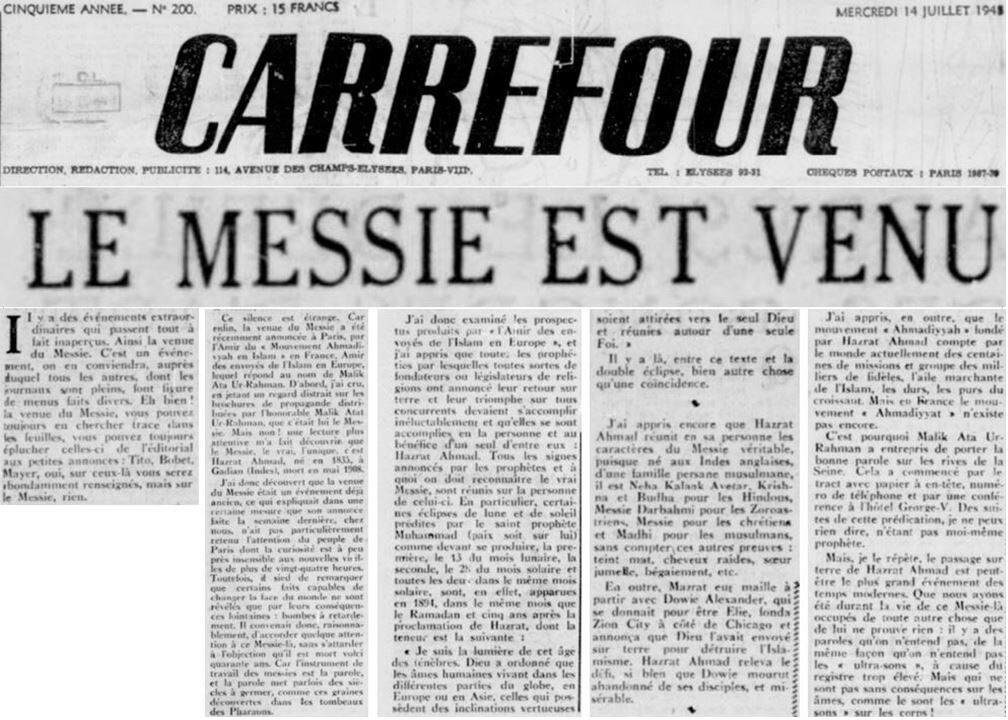
In 1948, Hazrat Musleh-e-Maudra instructed Malik Ataur Rahman Sahib – a missionary serving in France at the time – to visit Belgium. He visited Brussels and Antwerp and was interviewed by several newspapers in Belgium, including Le Phare Dimanche. It states:
“Islam Invades Europe!
“Islam, a religion of continuous transformation, has always produced a number of prophets, some of them creating schisms and sects, which exist up to now; others have disappeared without leaving a trace.
“A few days ago, a little man, with intelligent eyes and a lowered gaze, presented himself as the representative of the ‘Messiah’ at the Phare Dimanche.
“According [to him], a Messiah has appeared in India (where he died in 1908) and has instructed his disciples to spread his message to the corners of the world. This is how, without the help of the sword, Muslims are trying to convert Christians to [the faith of] the Quran! This is, to say the least, a new and original [endeavour].
“According to this envoy (‘Amir’ of the Ahmadiyya Movement), the prophet Hazrat Ahmad[as] is the Messiah. It was prophesied that the Messiah would be of tanned complexion and would have straight hair (as did Hazrat Ahmad[as]). The prophecy says that he would have a twin sister; he would be born in a village named Kad’a; he would stammer slightly and would suffer from two ailments: All these signs were fulfilled in Hazrat Ahmad[as].
“He is ‘Krishna’ and ‘Buddha’ for the Hindus, ‘Mesio’ for the Zoroastrians, ‘Messiah’ for the Christians, and ‘Mahdi’ for the Muslims. How can one ever doubt this? How can one ever doubt the fulfilment of the prophecy that ‘the whole world, in the end, will accept Islam’?
“According to the ‘Amir’, the Ahmadiyya Movement has established communities everywhere in the world, even in the United States, the United Kingdom and France. He wants to establish one at least in Belgium.
“What else can [we] do but wish good luck to this man? Are not all beliefs worthy [of our] respect?” (Le Phare Dimanche, 19 December 1948)


